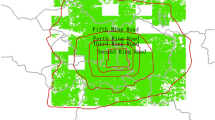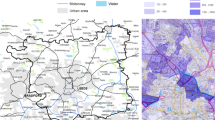Abstract
Crime analysis is important for social security management. With the advance of crowd sensing techniques, abundant multisource crowd sensed data could be used for crime analysis. The occurrence of crimes usually has some patterns in terms of temporal and spatial aspects. Investigating the spatio-temporal correlation of crimes could provide more useful cues for crime analysis and help discover underlying crime patterns. In this paper, we conduct a spatio-temporal study to understand urban crimes leveraging multisource crowd sensed data, including crime data, meteorological data, POI distribution, and taxi trips. Specifically, we first present monthly temporal trends and spatial distribution of crimes. We then investigate the spatio-temporal correlation using meteorological data (e.g., weather conditions and air temperature) and POI distribution and taxi trips. It is found that taxi trips and air temperature have a strong correlation with the crime, and some POI categories have a valuable correlation with the crime, e.g., College & University. We also find that Overcast days would witness more crime than other weather conditions.















Similar content being viewed by others
References
City of new york. (2020) https://www1.nyc.gov/
Adler J, Parmryd I (2010) Quantifying colocalization by correlation: the pearson correlation coefficient is superior to the mander’s overlap coefficient. Cytometry Part A 77(8):733– 742
Bales E, Nikzad N, Quick N, Ziftci C, Patrick K, Griswold WG (2019) Personal pollution monitoring: mobile real-time air quality in daily life. Pers Ubiquit Comput 23(2):309–328
Bao J, Zheng Y, Mokbel MF (2012) Location-based and preference-aware recommendation using sparse geo-social networking data. In: Proceedings of the 20th international conference on advances in geographic information systems, SIGSPATIAL ’12, pp 199-208. ACM, New York, NY, USA
Benesty J, Chen J, Huang Y, Cohen I (2009) Pearson correlation coefficient. In: Noise reduction in speech processing, Springer, pp 1–4
Bogomolov A, Lepri B, Staiano J, Oliver N, Pianesi F, Pentland A (2014) Once upon a crime: towards crime prediction from demographics and mobile data. In: Proceedings of the 16th international conference on multimodal interaction, ACM, pp 427–434
Bouyahia Z, Haddad H, Jabeur N, Yasar A (2019) A two-stage road traffic congestion prediction and resource dispatching toward a self-organizing traffic control system. Pers Ubiquit Comput 23 (5-6):909–920
Chen C, Ding Y, Wang Z, Zhao J, Guo B, Zhang D (2019) Vtracer: When online vehicle trajectory compression meets mobile edge computing. IEEE Syst J 14(2):1635–1646
Chen C, Ding Y, Xie X, Zhang S, Wang Z, Feng L (2019) Trajcompressor: an online map-matching-based trajectory compression framework leveraging vehicle heading direction and change. IEEE Trans Intell Transp Syst 21(5):2012– 2028
Chen C, Zhang D, Ma X, Guo B, Wang L, Wang Y, Sha E (2016) Crowddeliver: Planning city-wide package delivery paths leveraging the crowd of taxis. IEEE Trans Intell Transp Syst 18(6):1478–1496
Chen L, Fan X, Wang L, Yu Z, Li J, Zhang D, Nguyen TMT, Pan G, Wang C (2018) Radar: Road obstacle identification for disaster response leveraging cross-domain urban data. In: Proceedings of the 2018 ACM international joint conference on pervasive and ubiquitous computing, ACM, Singapore, pp 130–152
Chen L, Zhang D, Pan G, Ma X, Yang D, Kushlev K, Zhang W, Li S (2015) Bike sharing station placement leveraging heterogeneous urban open data. In: Proceedings of the 2015 ACM international joint conference on pervasive and ubiquitous computing, ACM, Osaka, Japan, pp 571–575
Chen L, Zhang D, Pan G, Ma X, Yang D, Kushlev K, Zhang W, Li S (2015) Bike sharing station placement leveraging heterogeneous urban open data. In: Proceedings of the 2015 ACM international joint conference on pervasive and ubiquitous computing, UbiComp ’15, ACM, New York, NY, USA, pp 571–575
Chen L, Zhang D, Wang L, Yang D, Ma X, Li S, Wu Z, Pan G, Nguyen TMT, Jakubowicz J (2016) Dynamic cluster-based over-demand prediction in bike sharing systems. In: Proceedings of the 2016 ACM International Joint Conference on Pervasive and Ubiquitous Computing, ACM, Heidelberg, Germany, pp 841– 852
Dai J, Yang B, Guo C, Ding Z (2015) Personalized route recommendation using big trajectory data. In: 2015 IEEE 31St international conference on data engineering (ICDE), IEEE, pp 543–554
Department NYCP (2020) Nypd complaint data. https://data.cityofnewyork.us/Public-Safety/NYPD-Complaint-Data-Historic/qgea-i56i
Foursquare. (2018) https://foursquare.com
Gerber MS (2014) Predicting crime using twitter and kernel density estimation. Decis Support Syst 61:115–125
Guo B, Li J, Zheng VW, Wang Z, Yu Z (2018) Citytransfer: Transferring inter-and intra-city knowledge for chain store site recommendation based on multi-source urban data. Proc ACM Interact Mob Wearable Ubiquitous Technol 1(4):1–23
Guo S, Chen C, Wang J, Liu Y, Ke X, Yu Z, Zhang D, Chiu DM (2019) Rod-revenue: Seeking strategies analysis and revenue prediction in ride-on-demand service using multi-source urban data. IEEE Transactions on Mobile Computing
Liu Y, Guo B, Li N, Zhang J, Chen J, Zhang D, Liu Y, Yu Z, Zhang S, Yao L (2019) Deepstore: an interaction-aware wide&deep model for store site recommendation with attentional spatial embeddings. IEEE Internet Things J 6(4):7319–7333
Maciag M (2016) Mapping the nation’s most densely populated cities. Governing–the States and Localities. Archived from the original on August 27
Panek S, Hinson J, Aversa J (2019) Local area gross domestic product, 2018. Tech. Rep. BEA 19-65 Bureau of Economic Analysis
Ranson M (2014) Crime, weather, and climate change. J Environ Econ Manag 67(3):274–302
Shang J, Zheng Y, Tong W, Chang E, Yu Y (2014) Inferring gas consumption and pollution emission of vehicles throughout a city. In: Proceedings of the 20th ACM SIGKDD international conference on Knowledge discovery and data mining, pp 1027–1036
Smith MD (2020) Sexual harassment: a reference handbook. ABC-CLIO
Song X, Zhang Q, Sekimoto Y, Shibasaki R, Yuan NJ, Xie X (2015) A simulator of human emergency mobility following disasters: Knowledge transfer from big disaster data. In: Twenty-ninth AAAI conference on artificial intelligence
Song X, Zhang Q, Sekimoto Y, Shibasaki R, Yuan NJ, Xie X (2016) Prediction and simulation of human mobility following natural disasters. ACM Trans Intell Syst Technol (TIST) 8(2):1–23
Taxi N, Commission L (2018) Nyc taxi dataset. http://www.nyc.gov/taxi
Traunmueller M, Quattrone G, Capra L (2014) Mining mobile phone data to investigate urban crime theories at scale. In: International conference on social informatics, Springer, pp 396–411
Underground, W. (2020) https://www.wunderground.com/weather/api
Vomfell L, Härdle WK, Lessmann S (2018) Improving crime count forecasts using twitter and taxi data. Decis Support Syst 113:73–85
Wang B, Shaaban K, Kim I (2019) Revealing the hidden features in traffic prediction via entity embedding. Pers Ubiquit Comput 1–11
Wang H, Kifer D, Graif C, Li Z (2016) Crime rate inference with big data. In: Proceedings of the 22nd ACM SIGKDD international conference on knowledge discovery and data mining, ACM, pp 635–644
Wang Q, Guo B, Wang L, Xin T, Du H, Chen H, Yu Z (2017) Crowdwatch: Dynamic sidewalk obstacle detection using mobile crowd sensing. IEEE Internet of Things J 4(6):2159–2171
Wikipedia: New york city. (2020) https://en.wikipedia.org/wiki/New_York_City
Wu D, Cui Y (2018) Disaster early warning and damage assessment analysis using social media data and geo-location information. Decis Support Syst 111:48–59
Yang D, Heaney T, Tonon A, Wang L, Cudré-Mauroux P (2017) Crimetelescope: crime hotspot prediction based on urban and social media data fusion. World Wide Web 1–25
Yi X, Zhang J, Wang Z, Li T, Zheng Y (2018) Deep distributed fusion network for air quality prediction. In: Proceedings of the 24th ACM SIGKDD international conference on knowledge discovery & data mining, pp 965–973
Yu Z, Zhang D, Wang Z, Guo B, Roussaki I, Doolin K, Claffey E (2017) Toward context-aware mobile social networks. IEEE Commun Mag 55(10):168–175
Yu Z, Zhang D, Yu Z, Yang D (2015) Participant selection for offline event marketing leveraging location-based social networks. IEEE Trans Syst Man Cybern Syst 45(6):853–864
Zhao S, Li S, Ramos J, Luo Z, Jiang Z, Dey AK, Pan G (2019) User profiling from their use of smartphone applications: a survey. Pervasive Mob Comput 59:101052
Zhao S, Pan G, Tao J, Luo Z, Li S, Wu Z (2020) Understanding smartphone users from installed app lists using boolean matrix factorization. IEEE Transactions on Cybernetics
Zhao S, Ramos J, Tao J, Jiang Z, Li S, Wu Z, Pan G, Dey AK (2016) Discovering different kinds of smartphone users through their application usage behaviors. In: Proceedings of the 2016 ACM international joint conference on pervasive and ubiquitous computing, pp 498–509
Zheng Y, Liu T, Wang Y, Zhu Y, Liu Y, Chang E (2014) Diagnosing new york city’s noises with ubiquitous data. In: Proceedings of the 2014 ACM international joint conference on pervasive and ubiquitous computing. ACM, Seattle, US, pp 715–725
Zhou B, Chen L, Zhou F, Li S, Zhao S, Das SK, Pan G (2020) Escort: Fine-grained urban crime risk inference leveraging heterogeneous open data. IEEE Systems Journal
Zhou B, Zhao S, Chen L, Li S, Wu Z, Pan G (2020) Forecasting price trend of bulk commodities leveraging cross-domain open data fusion. ACM Trans Intell Syst Technol (TIST) 11(1):1–26
Zhu JY, Sun C, Li VO (2017) An extended spatio-temporal granger causality model for air quality estimation with heterogeneous urban big data. IEEE Trans Big Data 3(3):307–319
Funding
This work is supported by Ten Thousand Talent Program of Zhejiang Province (Grant No. 2018R52039).
Author information
Authors and Affiliations
Corresponding author
Ethics declarations
Conflict of interest
The authors declare that they have no conflict of interest.
Additional information
Publisher’s note
Springer Nature remains neutral with regard to jurisdictional claims in published maps and institutional affiliations.
Rights and permissions
About this article
Cite this article
Zhou, B., Chen, L., Zhao, S. et al. Spatio-temporal analysis of urban crime leveraging multisource crowdsensed data. Pers Ubiquit Comput 27, 599–612 (2023). https://doi.org/10.1007/s00779-020-01456-6
Received:
Accepted:
Published:
Issue Date:
DOI: https://doi.org/10.1007/s00779-020-01456-6




